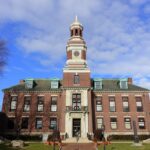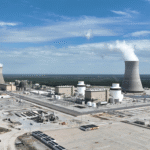Energy News Beat
A pair of community microgrid projects in Massachusetts are already helping to inspire similar projects in the state before construction has even begun.
The city of Chelsea and Boston’s Chinatown neighborhood are each developing projects that supporters hope can become powerful case studies for the potential of microgrids to increase resilience and create other benefits for residents.
Chelsea has ordered equipment for a microgrid that will connect municipal facilities, and is targeting a construction date in the second half of 2024. Chinatown is finalizing plans for a system to provide solar power and backup energy storage to a 200-unit affordable housing apartment building.
“We do see this serving as a model for the nation if we can pull it off,” said Alexander Train, Chelsea’s director of housing and community development.
The list of communities considering whether to follow their lead includes Cambridge, Lynn, and Milton.
Get connected
Every morning, thousands of energy professionals turn to our newsletters for the day’s most important news. Sign up for free to get the latest delivered straight to your inbox.
In the broadest sense, microgrids are small-scale energy systems in which power is produced, distributed, and consumed, typically all within a self-contained area such as a college campus or hospital complex. Microgrids can often operate independently from the main grid, providing continuous power, even in case of disruptions to the regional supply, and can help cut energy costs.
Though they come in all configurations and sizes, microgrids have historically generated power with fossil fuels. But as the transition to sustainable energy accelerates, more organizations are looking at ways to combine renewable energy and battery storage to create cleaner microgrids.
Several years ago, semi-retired engineer David Dayton saw in this evolving model an opportunity to improve the health and safety of environmental justice communities — areas that bear a disproportionate environmental burden and are often home to many low-income residents and people of color.
Solar panels could cut energy costs, while batteries could provide power to critical facilities, such as municipal buildings, community centers, and senior housing, in case of power outages. Batteries could also be used to sell power back to the main grid to help pay for the system.
To get this vision off the ground, Dayton reached out to organizations he was familiar with, including the Green Justice Coalition and private companies Peregrine Energy Group and Synapse Energy Economics. The participants identified Chelsea and Chinatown as good candidates for a community microgrid. Both communities have high populations of immigrants and people of color, and both have median household incomes well below the average for the area. And they are vulnerable to climate change impacts including flooding and dangerous temperatures as the result of the urban heat island effect.
In 2018, the group Dayton assembled acquired grants from the Massachusetts Clean Energy Center for feasibility studies in the two communities.
The model developed during this process proposes to create the nation’s first community-owned “virtual microgrid.” The designs use cloud-based software to connect solar installations and batteries in locations that aren’t necessarily adjacent to each other, a departure from the conventional model in which the components of the microgrid are physically connected. This approach allows more flexibility in deciding what facilities can participate, particularly helpful when a community would like to include vital facilities that are geographically spread out.
“It’s a microgrid without borders,” Dayton said. “We can add any building to the network at any time — they don’t have to be contiguous.”
Today, the first two projects are making progress. In Chelsea, a design has been created that includes 500 kilowatt-hour batteries at both the police station and city hall, as well as a 400 kilowatt solar array at the department of public works facility. Plans are already in the works to start gathering more community input by the end of the year about expanding the system to other essential locations such as senior housing, churches, or health care centers.
“We want this system to proliferate as fast as we possibly can,” Train said.
In Chinatown, project developers have had to scale back their initial ambitions of connecting several multifamily housing buildings. They are now focused on serving Masspike Towers, a privately owned development of 190 affordable units, before expanding. The plan, still being finalized, is to build a solar installation and share the savings across all residents in a model similar to community solar. Battery storage will help keep common areas powered and extensive energy efficiency measures will reduce overall consumption.
“Our goal is to bring the benefits of clean energy and decarbonization incentives to a low-income urban community that has historically missed out on a lot of those benefits,” said Lydia Lowe, executive director of the Chinatown Community Land Trust, one of the community partners in the project
As work has progressed in Chelsea and Chinatown, other communities have started to wonder about the possibilities. And the two ongoing projects are offering valuable lessons about how to make community microgrids work.
Financing has emerged as a potential major sticking point. In Chelsea, where the city will own the system, the city council voted to provide $4 million in funding to the project. That money – along with federal support, the savings created by solar generation, and the revenue from selling stored powerback onto the grid – is enough to get the project up and running. Building on municipal sites that each have only one tenant also helps simplify the design and logistics.
In Chinatown, however, the city is providing some funding, but not enough to cover the entire project, making it more challenging to structure the financing in a way that is affordable yet satisfies potential investors.
“It is a little bit tougher. We were able to get the city on board in Chelsea,” said Sari Kayyali, microgrid manager for the two projects. “We’ve been working with them to find a workable scope that can pay back investors in a timely manner.”
The work thus far has also highlighted the importance of the community-led ethos that distinguishes the approach from other microgrids, which are generally privately owned and operated. From the beginning, Dayton and other planners felt it was essential to the underlying mission of environmental justice that community members have a lot of say in determining the goals, design, and operations of these community microgrids. In both Chelsea and Chinatown, the planners divided the $75,000 each community received, dedicating half to engineering and technical planning, and giving the other half to community organizations to conduct outreach and education.
In Chelsea, these efforts were key to securing the microrid’s future: The strong support of the community helped sway a few skeptical city councilors to vote for funding for the project, said Elena González, technical director of Climable, a nonprofit that has conducted community engagement and outreach for Chelsea, Chinatown, and Cambridge.
But the importance of community involvement is far more than just strategic, supporters said.
“These microgrid projects empower communities and give them a role in the way that energy development happens,” González said. “This is something that has a huge impact in people’s lives and it is important that the community leads.”
Related
The post Microgrid model spreads in Massachusetts as cities look to lessen costs, outages appeared first on Energy News Beat.








